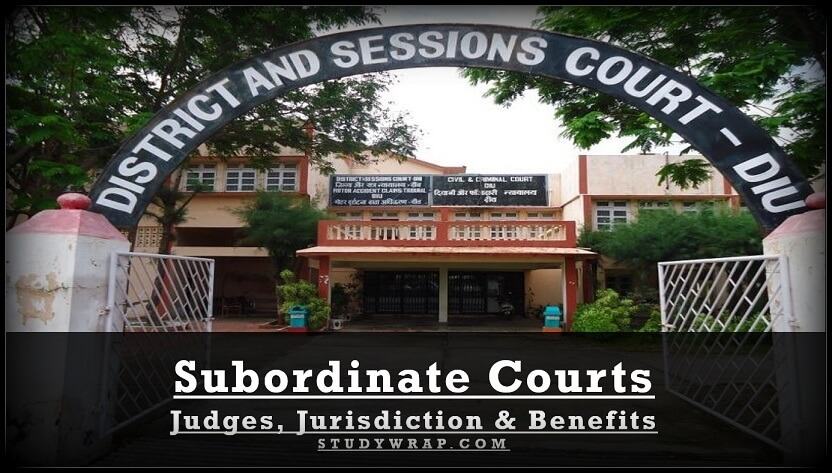Polity
Subordinate Courts – Judges, Jurisdiction & Benefits
Subordinate Courts
Table of Contents
Judiciary in India
- India is a federal State with single & unified judicial system with three tier structure –
- Supreme Court at top
- High Courts at state/s level and
- Subordinate Courts at district level.
- The subordinate courts are so called because of their subordination to the state high court. They function below and under the high court at district and lower levels.

Constitutional Provisions for Subordinate Courts
- Part VI from Article 233 to 237 of the Indian Constitution.
- State judiciary system consists of a High Court and a hierarchy of subordinate courts below it, also known as lower courts.
- They function below and under the High Court at district and lower levels.
|
Article |
Subject |
|
233 |
Appointment of district judges |
|
233A |
Validation of appointments, judgements, etc., delivered by certain district judges |
|
234 |
Recruitment of persons other than district judges to the judicial service |
|
235 |
Control over subordinate courts |
|
236 |
Interpretation |
|
237 |
Application of the provisions to certain class or classes of Magistrates |
Appointment of District Judge
- The appointment, posting and promotion of district judges in a state are made by the Governor of the state in consultation with the High Court.
Qualification Criteria
-
- A person to be appointed as district judge should have the following qualifications –
- He should not already be in the service of the Central or the state government.
- He should have been an advocate for 7 years.
- He should be recommended by the High Court for appointment.
- A person to be appointed as district judge should have the following qualifications –
Appointment of Other Judges
- Made by the Governor of the state after consultation with the State Public Service Commission and the High Court of concerned state.
Control over Subordinate Courts
- The control over district courts and other subordinate courts including the posting, promotion and leave of persons belonging to the judicial service of a state and holding any post inferior to the post of district judge is vested in the High Court.
Application of the Above Provisions to Certain Magistrates
- The Governor may direct that the above mentioned provisions relating to persons in the state judicial service would apply to any class or classes of magistrates in the state.
Structure and Jurisdiction
- The organisational structure, jurisdiction and nomenclature of the subordinate judiciary are laid down by the states.
- Hence, they differ slightly from state to state.
- Broadly, there are three tiers of civil and criminal courts below the HC of state.
- The district judge is the highest judicial authority in the district.
- He possesses original and appellate jurisdiction in both civil and criminal matters.
- When he deals with –
- Criminal matters – District judge is known as the Sessions judge.
- Civil matters – District judge known as the District judge.
- The district judge exercises both judicial and administrative powers.
- He also has supervisory powers over all the subordinate courts in the district.
- Appeals against his orders and judgements lie to the High Court.
- The Sessions judge has the power to impose any sentence including life imprisonment and capital punishment (death sentence).
- NOTE – Capital punishment passed by him is subject to confirmation by the High Court, whether there is an appeal or not.
- The subordinate judge exercises unlimited pecuniary jurisdiction over civil suits.
- Below the District and Sessions Court stands the Court of Subordinate Judge on the civil side and the Court of Chief Judicial Magistrate on the criminal side.
- The chief judicial magistrate decides criminal cases which are punishable with imprisonment for a term upto 7 years.
Issues with District and Subordinate Courts
- High level of vacancy for the posts of judges.
- Pendency of cases are major issues which impedes efficient and effective justice delivery to citizens.
- Issues in recruitment – Sluggishness and procrastination in the process of calling for applications, holding recruitment examinations and declaring the results.
- Lack of uniformity in frequency of hearings among the subordinate courts in the country.
- Inordinate delays in evidence collection and examination of witnesses which impacts the overall process of the court.
Impacts of Judicial Pendency
- Delayed justice is denied justice – Speedy trial is a part of right to life and liberty (Article 21).
- Loss of social and ethical infrastructure- Negative effect on social development, higher crime rates and erodes credibility of institution.
- Overcrowding of the prisons
- Affects the economy of the country
- Pendency hampers dispute resolution, contract enforcement, discourage investments, stall projects, hamper tax collection and escalate legal costs which leads to Increasing cost of doing business.
Solution for Efficient Working of Subordinate Courts
- A smooth and time-bound process of making appointments requires close coordination between the HC and the State Public Service Commissions.
- The induction and capacity building of both manpower and resources.
- Strengthening of court infrastructure and leveraging ICT- E.g LIMBS, e-Courts
- Proportionate recruitment of legal and paralegal staff too has to be addressed.
- Create an All-India Judicial Service (AIJS) to attract the best talent in India’s legal profession.
- Increase in number of working days could improve productivity and efficiency significantly.
So, this is all about the introductory post on the Subordinate Courts . If you want to read more notes on Indian Polity – Click Here.
In the Next Post (Click Here), we will learn about the Independence of Supreme Court of India.
If you Like this Post than please share it with your friends and family and like our Facebook Page to get regular updates. Sharing is Caring J.

